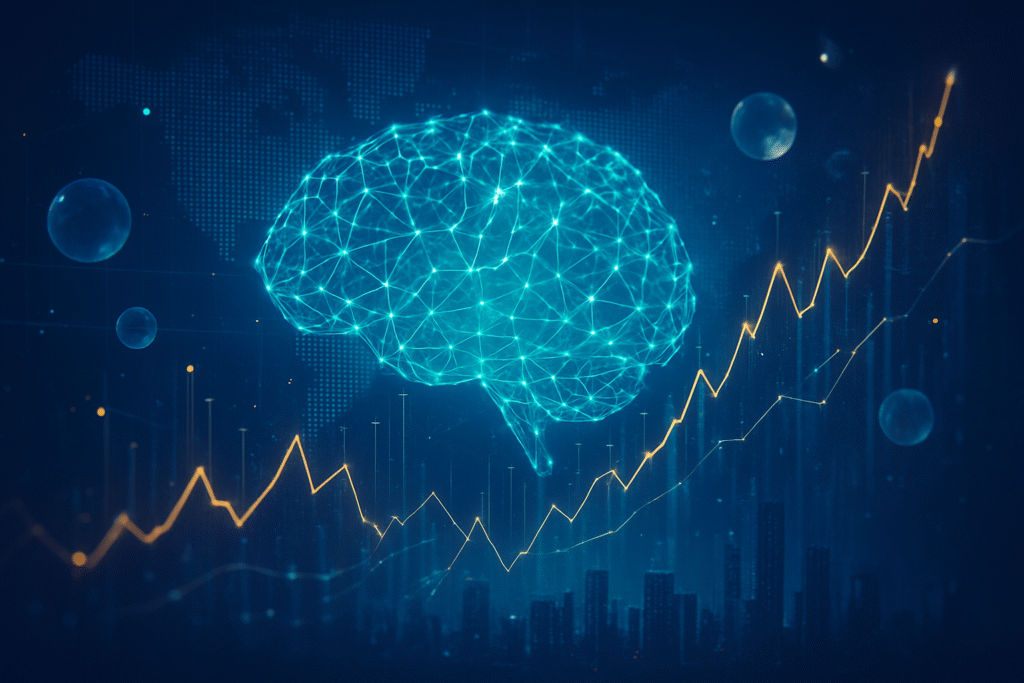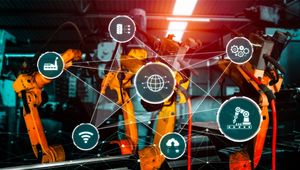
The world of Artificial Intelligence is experiencing an unprecedented surge in investment and trade as 2025 draws to a close, marking a pivotal moment in technological advancement. With global AI market projections soaring into the hundreds of billions, and even trillions by the next decade, the industry is awash with capital, innovation, and strategic maneuvers from tech giants and nimble startups alike. This rapid expansion, while heralding transformative potential across every sector, has simultaneously ignited fervent debate among economists and industry leaders: Is the AI market on a path of sustainable growth, or are we witnessing the nascent stages of an investment bubble reminiscent of past tech booms?
This immediate significance lies in the dual forces at play: the undeniable, accelerating demand for AI capabilities, from sophisticated algorithms powering financial trading to the vast computational infrastructure underpinning generative models, and the cautious warnings from figures like Jeff Bezos and Sam Altman about potential overinvestment. As capital pours into data centers, specialized hardware, and AI research, the industry is grappling with how to balance aggressive expansion with long-term viability, ethical considerations, and a genuine return on investment beyond inflated valuations.
The AI Investment Avalanche: Billions Poured into Infrastructure and Innovation
The current AI investment landscape is characterized by staggering figures and a strategic shift towards foundational infrastructure. Global AI market size estimates for 2025 range widely, from US$243.72 billion (Statista) to USD 757.58 billion (Precedence Research), with some projections exceeding $371 billion, all indicating robust, multi-year growth at CAGRs often above 19-30%. Goldman Sachs Research, a prominent financial institution, anticipates global AI investment nearing $200 billion by the end of 2025. This financial deluge is not merely speculative; it is largely driven by hyperscalers such as Microsoft (NASDAQ: MSFT), Alphabet (NASDAQ: GOOGL), Amazon (NASDAQ: AMZN), and Meta (NASDAQ: META), who are projected to invest upwards of $200 billion in capital expenditures (CapEx) in 2024, potentially reaching $250 billion, or even $405 billion, by 2025. These monumental investments are primarily channeled into the construction of advanced AI data centers, demanding specialized hardware like high-performance GPUs and CPUs, pushing the global data center infrastructure market towards an anticipated $1 trillion in annual spending by 2030.
This current investment wave differentiates itself from previous tech booms in several key aspects. While the dot-com era was marked by speculative investments in often unprofitable companies, today's AI spending is largely backed by the robust balance sheets and significant profits of established tech giants. The demand for AI compute is not merely theoretical; it's exponential, driven by tangible and rapidly increasing AI usage across diverse applications, from enhancing trade and investment management to optimizing supply chains and customer service. For instance, the AI in trading market alone is expected to swell from $10 billion in 2025 to approximately $60 billion by 2033, highlighting a clear, revenue-generating application of AI technology. However, concerns persist, with some analysts pointing to a widening gap between market expectations and real-world utility, citing reports that suggest a significant percentage of organizations are seeing minimal returns despite substantial generative AI investments.
Initial reactions from the AI research community and industry experts are a mix of excitement and caution. While the rapid advancements and increased funding are welcomed for accelerating innovation, there's a palpable anxiety about the sustainability of current valuations and the ethical implications of such pervasive technology. OpenAI CEO Sam Altman, a leading figure in generative AI, has openly warned that "people will overinvest and lose money" in this current phase. Similarly, Amazon (NASDAQ: AMZN) founder Jeff Bezos has described the environment as "kind of an industrial bubble." These warnings underscore a critical sentiment: while AI's potential is immense, the market's trajectory requires careful monitoring to prevent a severe correction, with six key indicators—AI investments, data center construction, AI adoption, AI price levels, company competition, and public trust—under constant scrutiny.
Corporate Fortunes in the AI Gold Rush: Giants Consolidate, Startups Navigate a Rollercoaster
The unprecedented AI investment boom, while propelling the industry forward, has created a complex and often volatile landscape for companies across the spectrum. Tech giants, with their vast resources and established infrastructure, are strategically positioned to capitalize on the surge, while specialized AI firms ride waves of astonishing growth but face intense scrutiny over their valuations. Startups, meanwhile, navigate a "new gold rush" characterized by both immense opportunity and significant hurdles.
Leading the charge are the "magnificent seven" AI-related stocks, including Nvidia (NASDAQ: NVDA), Microsoft (NASDAQ: MSFT), Alphabet (NASDAQ: GOOGL), Amazon (NASDAQ: AMZN), Meta (NASDAQ: META), Apple (NASDAQ: AAPL), and Oracle (NYSE: ORCL), which have seen substantial gains. Nvidia, in particular, has cemented its dominance in the crucial GPU market, commanding an 87% share, making its hardware indispensable for powering AI applications. Its valuation, reaching $4.5 trillion in November 2025, underscores its pivotal role, though it also attracts skepticism and short-selling. Microsoft has leveraged its strategic partnership with OpenAI, doubling down on AI-powered productivity tools and its Azure AI platform, which saw a 27% jump in cloud revenue in 2025 due to AI workloads. Alphabet's Google DeepMind, with its advancements like Gemini 2.0, has helped the company catch up in the AI race, contributing to strong revenue milestones. These tech behemoths benefit from deep pockets, the ability to acquire promising startups, and established cloud infrastructure, leading to increased consolidation in the AI industry.
For specialized AI companies like OpenAI and Anthropic, the boom has translated into astonishing valuations—$300 billion and $61.5 billion respectively in mid-2025 for these private entities. Anthropic's annual sales growth of 1,000% year-over-year to $3 billion by mid-2025 exemplifies the explosive potential. However, these high valuations are often based on speculative future growth rather than current profitability, making them particularly vulnerable to market corrections. OpenAI, for instance, reported a $13.5 billion loss in the first half of 2025 despite $4.3 billion in revenue, highlighting the significant investment required to scale. These firms also grapple with intense competition for scarce AI talent, leading to exorbitant salaries and recruitment challenges.
Startups, while attracting 58% of the total $73 billion in venture capital funding in Q1 2025, face a "rollercoaster" environment. AI has become a "not-so-secret weapon," with many reporting lower customer acquisition costs and improved upsell capabilities. Yet, they contend with a severe talent gap, often losing experts to tech giants. Challenges also include data quality issues, privacy and security concerns, and growing legal and intellectual property risks. The most successful startups in this climate are "AI-native" companies, built from the ground up with machine learning at their core, focusing on solving specific pain points. The competitive landscape is becoming increasingly concentrated, with a small group of companies securing most major deals, raising concerns about potential contagion if the promises of AI fall short for broader enterprises, as indicated by a MIT report in August 2025 stating that 95% of organizations are getting zero return despite massive investment in generative AI. The rise of agentic AI systems, capable of autonomous decision-making and complex workflows, also poses a significant disruptive threat to traditional software paradigms, potentially impacting legacy application-layer players.
Beyond the Hype: AI's Broader Impact, Bubble Warnings, and Ethical Crossroads
The current AI trade and investment frenzy, far from being an isolated phenomenon, is profoundly reshaping the broader technological and societal landscape. This "AI spring," marked by rapid advancements, particularly in generative AI, and accelerated investment, is seen as a transformative period that will redefine industries, economies, and even the fabric of society. Global AI spending is projected to exceed $500 billion annually by 2026, with an estimated $280 billion already invested globally in 2025, a significant 40% increase from the previous year. This capital infusion is not just fueling innovation but is seen as a strategic imperative, with three-quarters of executives naming AI as a top-three strategic priority for 2025.
However, this explosive growth comes with a growing chorus of concerns about a potential market bubble, drawing strong parallels to the dot-com era. Experts like Jarek Kutylowski (DeepL CEO) and Hovhannes Avoyan (Picsart CEO) voice apprehension over "exaggerated valuations" for many AI companies that lack substantial revenue or profitability. The "circular financing" phenomenon, where leading AI tech firms invest in each other to potentially inflate stock values—such as Nvidia (NASDAQ: NVDA) making a $100 billion investment in OpenAI, which also counts Microsoft (NASDAQ: MSFT) as a major shareholder, while Microsoft is a significant customer of CoreWeave (another company with Nvidia's equity stake)—further fuels these bubble fears. The market's high concentration, with the five largest companies holding 30% of the US S&P 500 and 20% of the MSCI World index in late 2025, represents the greatest concentration in half a century, exacerbating these concerns and leading to sharp declines in global stock markets in early November 2025.
Beyond market volatility, the societal impacts are vast and multifaceted. AI is poised to drive the next efficiency wave, potentially adding trillions to the global economy and addressing decades of low economic growth. Yet, it also threatens to profoundly reshape the labor market, with projections of 11 million new jobs by 2030 but also the displacement of 9 million, impacting up to 40% of global jobs. This necessitates massive investments in reskilling and upskilling to prevent widening inequality. Furthermore, the immense energy consumption of AI, particularly in training and deploying large models, poses environmental challenges. UN Trade and Development (UNCTAD) warns that without inclusive investment in digital infrastructure and capabilities, AI risks exacerbating existing inequalities, especially for developing countries.
Ethical considerations are becoming paramount, with over $10 billion projected for AI ethics and responsible AI initiatives in 2025. Concerns range from algorithmic bias perpetuating societal inequalities in hiring and criminal justice, to data privacy and consent issues given AI's vast data requirements. The "black box" problem of opaque AI decision-making, the potential for manipulation through deepfakes, and complex questions of accountability and intellectual property ownership are all critical areas demanding robust regulatory frameworks and proactive ethical adaptation. While the current AI boom shares historical echoes with past tech surges like the dot-com bubble, its unprecedented scale, breadth of application, and geopolitical stakes—with governments actively funding initiatives to secure technological leadership—distinguish it as a truly unique and transformative moment in human history.
The Road Ahead: AI Agents, Trillions in Economic Impact, and the Quest for Sustainable Innovation
Looking beyond the immediate investment frenzy, the future of AI trade and investment from late 2025 onwards promises an era of profound transformation, marked by increasingly sophisticated applications, massive economic impact, and a critical focus on sustainable growth. Near-term developments are characterized by a continued surge in capital expenditure and a strategic pivot from foundational model development to practical, industry-specific integration.
In the near term (late 2025 – 2028), AI is expected to maintain its dominance in venture capital funding, accounting for over 50% of global VC funding in 2025, with investments concentrated in larger "mega-rounds." Tech giants like Microsoft (NASDAQ: MSFT), Amazon (NASDAQ: AMZN), and Alphabet (NASDAQ: GOOGL) are projected to collectively increase their AI infrastructure capital expenditure to around $200 billion in 2025, with an estimated $2.9 trillion in AI infrastructure CapEx between 2025 and 2028. A key shift will be the rise of AI agents over traditional chatbots; these autonomous agents will be capable of executing entire workflows, making decisions, and interacting with the real world based on initial instructions. This move signifies a maturation of AI, from assistive tools to proactive problem-solvers. The market will also see a resurgence of "acqui-hires," as strategic buyers acquire companies primarily for their invaluable AI talent.
Longer-term, the economic implications are staggering. AI's impact on productivity could add trillions of dollars to the global economy, with generative AI alone potentially contributing an additional $2.6 trillion to $4.4 trillion annually. Projections suggest AI could add $15 trillion to the global economy by 2030 and reach $4.8 trillion in market value by 2033. This sustained productivity growth, potentially adding 0.1 to 0.6 percent annually through 2040, will reshape the global economic order. Beyond current AI applications, future growth frontiers include robotaxis, drones, space infrastructure, quantum technologies, and advanced nuclear, all attracting long-term, high-uncertainty investments. However, this transformation will also affect nearly 40% of jobs globally, necessitating robust strategies for workforce adaptation and reskilling.
Potential applications span every sector. In trade, AI will optimize logistics, demand forecasting, and customs procedures. In trade finance, it will revolutionize risk assessment, fraud detection, and provide predictive insights for cash flow. Investment management will see AI providing real-time portfolio insights, automating client communications, and enhancing trading strategies through sophisticated algorithms. Market analysis will be transformed by AI-driven analytics identifying consumer trends and enabling personalized marketing. Challenges persist, including ensuring high-quality data, addressing ethical concerns like bias and explainability, navigating complex regulatory landscapes, and managing the immense energy consumption of AI. Experts, as of late 2025, predict a sustained investment boom, with enterprise adoption of AI copilots and workflow tools being a key indicator of realized productivity gains. The global AI market is expected to reach $391 billion in 2025, with a five-fold increase in value over the next five years. Sustainable growth strategies will be paramount, emphasizing responsible AI development, resource efficiency, robust governance, international cooperation, and inclusive development to ensure AI benefits all of humanity.
The AI Epoch: A Defining Moment Demanding Vigilance and Vision
The current epoch of AI trade and investment, as 2025 draws to a close, stands as a defining moment in technological history. We are witnessing an unparalleled surge in capital, innovation, and strategic positioning, driven by the transformative potential of artificial intelligence. Key takeaways from this period include the monumental increase in global AI investment, projected to reach $280 billion in 2025, with a significant concentration of venture capital flowing into market leaders and foundational model developers. The shift towards robust infrastructure development, enterprise integration of AI copilots, and the monetization of AI across various ecosystem components underscores a maturation of the industry, moving beyond mere hype to tangible application.
This era’s significance in AI history is profound. It represents an "AI spring" fueled by exponential computing demand and rapid enterprise adoption, a stark contrast to previous "AI winters." The scale of financial exposure and investment concentration, particularly in digital infrastructure, may even surpass prior technology bubbles. While AI promises to be the next industrial revolution, fundamentally reshaping the global economy, its long-term impact carries both immense promise and considerable risks. AI is set to drive significant GDP growth and revolutionize international trade through optimized operations and enhanced market access. However, it also introduces concerns about increased market volatility, the concentration of investment in non-bank financial intermediaries, and the profound societal shifts that will accompany the pursuit of Artificial General Intelligence (AGI).
As we look to the coming weeks and months, vigilance will be key. Watch for continued capital expenditure from hyperscalers like Microsoft (NASDAQ: MSFT), Amazon (NASDAQ: AMZN), and Alphabet (NASDAQ: GOOGL), as these investments signal long-term confidence in AI demand. Chip innovation from Nvidia (NASDAQ: NVDA), AMD (NASDAQ: AMD), and Intel (NASDAQ: INTC) will remain crucial. The pace of enterprise adoption of AI tools, regulatory developments, and the industry's response to AI's substantial energy demands will be critical indicators. The mainstream adoption of autonomous AI agents is also an anticipated acceleration for 2025.
The debate surrounding an "AI bubble" remains central. While some experts warn of "exaggerated valuations" and circular financing akin to the dot-com era, others argue that fundamental differences, such as profit-funded spending and real demand, differentiate this boom. Regardless, the financial exposure and interconnectedness of the AI ecosystem demand careful monitoring. Crucially, efforts towards sustainable growth are gaining traction. Prioritizing responsible AI development, resource efficiency, robust governance, and inclusive development will be paramount. Governments and companies are increasingly leveraging AI for sustainability initiatives, but the "ESG of AI"—encompassing ethical, social, and environmental considerations—will require a balanced approach to ensure AI's transformative power benefits humanity without exacerbating existing inequalities.
This content is intended for informational purposes only and represents analysis of current AI developments.
TokenRing AI delivers enterprise-grade solutions for multi-agent AI workflow orchestration, AI-powered development tools, and seamless remote collaboration platforms.
For more information, visit https://www.tokenring.ai/.





